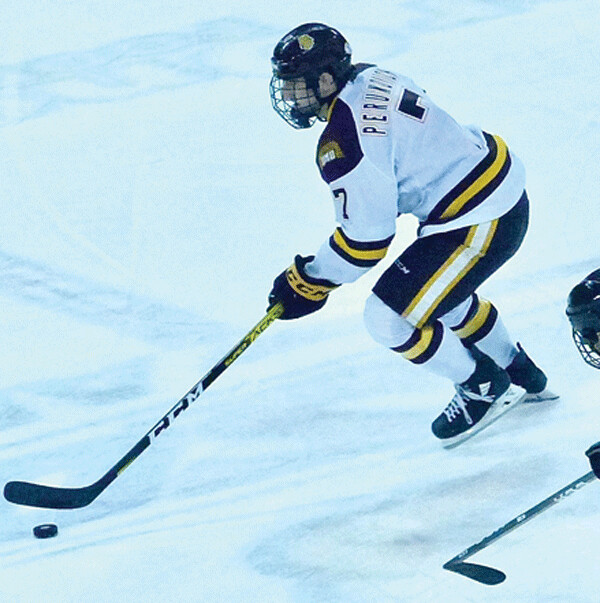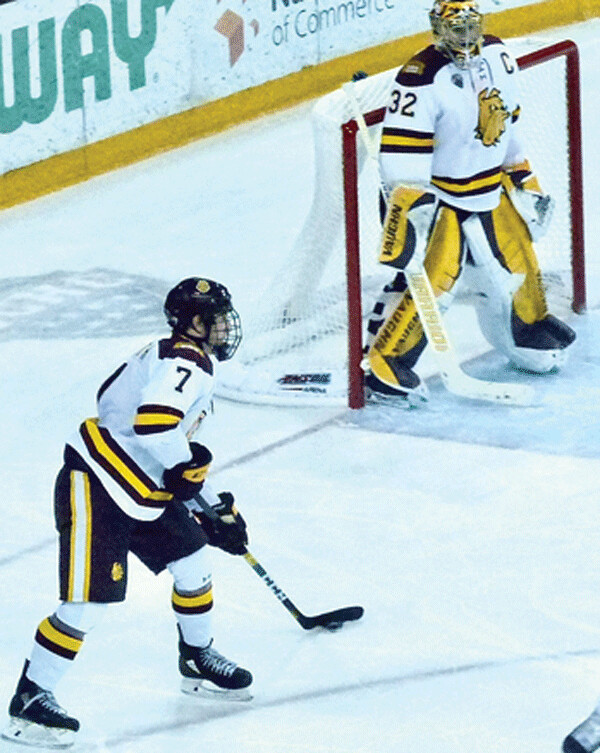News & Articles
Browse all content by date.

One of my long-time associates in the world of hockey noted last week that Scott Perunovich signed a contract to pass up his final year of eligibility at UMD and turn pro with the St. Louis Blues.
He asked me what I thought of Perunovich.
“Scott Perunovich has been the best reason for anyone to watch any hockey game at any level, for the three years he was at UMD,” I said.
Pretty simple. And true.
There are a lot of outstanding players in college hockey these days, many of them teammates with Perunovich, the junior defenseman from Hibbing. But you can go to any college game — back when there were college games to watch — and you could watch and note certain players who rose up to make an outstanding play to score a goal, or to set one up. There are so many good players that it seems as though you could open the mold and pour out another one. Very impressive, in total.
But in most cases, pouring another player out of a cookie-cutter mold is impressive, but somehow lacks the style, the flair, and the outright magnetism of Scott Perunovich.
Magnetism is the operative word, because if you went to the game without knowing any of the players, you would spot Perunovich soon enough, but you would have wasted a lot of game-time. The thing to do was to go to the game and always notice when Perunovich came on the ice, and then never take your eyes off him. Just to see if you might see something you’ve never seen before.
Perunovich wore No. 7 for the Bulldogs, and his three years have been nothing short of sensational. As a freshman, he was one of five rookies to join sophomore Nick Wolff on a defense that, on paper, doomed the Bulldogs to a rebuilding year. Instead, UMD won the NCAA title, by surprise, and Perunovich, a quick-striking puck-rusher who could shoot with the best of them but who could pass even better, to set up open teammates for big goals.
Perunovich led UMD in scoring that freshman year, which still astounds observers, because how often in college hockey history has a defenseman led a team in scoring, and how often in college hockey history has a freshman led a team in scoring, and how often in college hockey history has a freshman defenseman ever led an BCAA championship team in scoring. It doesn’t happen, but Perunovich made it happen with UMD.
Last season, Perunovich was leading the way again until he got injured, and missed several games. The Bulldogs were a surprise no longer, and while his injury may have prevented an NCHC title run, he came back and played at limited capacity as the Bulldogs again went into the NCAA regional, won it, and then won their second NCAA title in a row.
At last year’s tournament time, I asked Perunovich how close he was to 100 percent, and he said “about 90 percent.”
It was a fib, and as soon as this, his junior season began, it was obvious what the difference would be between last spring’s Perunovich and a healthy one. So I asked him again, now that he’s 100 percent, when he looks back to last season, how close was he?
“Probably about 65 percent,” he admitted.
In fact, because he knew he hadn’t finished with the flair he intended, he was determined to return to UMD and put his full talent on display. What we were able to witness will be stenciled on all our memories for all time.
UMD made a strong run at the NCHC title, and finished one victory short of North Dakota. That put the Bulldogs in a stronger position than either of the last two seasons, and I was convinced that this team was the best of the last three UMD teams and would win its third straight NCAA title. Scott Perunovich was the primary reason for my optimism.
A lot of times when a player scores a lot and most of his points are assists, you wonder how many of those were what they now call “secondary” assists, or maybe tack-on gifts. Nobody ever questioned a Scott Perunovich assist, however, because he absolutely took over command of a game’s tempo. That is not easy to do.
Back in the late 1970s and early '80s, I had the pleasure of watching two young brothers come out of Roseau High School to attend the University of Minnesota. Neal Broten came out in 1978 and coach Herb Brooks called him the most talented freshman he’d ever seen.
Broten helped a powerful Gopher team go all the way to the NCAA championship, chipping a diving shot into the North Dakota goal to win the title game. Then he went along with “ Brooks to glory at the 1980 Winter Olympics in Lake Placid, where he was the second-youngest player on the Miracle on Ice team.
Neal Broten had an incredible ability to sitickhandle down the ice at great speed, and as you watched him lead the rush, he might throw what looked like a throwaway pass, and you’d say, “What’s he doing? Oh…nice pass.”
His ability was a radar-like anticipation of where all his teammates were at all times, and he would make a pass to an open winger before you would notice the winger was open.
A year later, his brother, Aaron Broten, came to Minnesota, and was a similar star, if you looked at the point tallies. Aaron was an entirely different player. A little bigger, a little stronger, with a little bit of a harder shot, even with the same deft ability to anticipate and use his teammates. The difference was that Aaron would get the puck, and if he sensed he had 3 seconds before a foe confronted him, he might use up 2.8 of those seconds and then make a perfect pass.
Neal set the tempo of the game at ultra-fast, while Aaron regulated the tempo of the game by slowing the pace down in mesmerizing fashion and then capitalizing with a perfect play. You can imagine why they were so good together when Neal came back from the Olympics and went back together with brother Aaron and Butsy Erickson on an all-Roseau line.
In 1981, Neal Broten won the first Hobey Baker Award for being the best player in college hockey, after scoring 17 goals, 54 assists, for 71 points in 36 games. Aaron Broten played 45 games and scored 47 goals with 59 assists for a Gopher single season record 106 points, and didn’t win any awards, but he was awesome.

Flash forward 40 years, and the scene is AMSOIL Arena. The puck is thrown into the UMD end, and Hunter Shepard, the best goaltender in the country, goes behind the net to tee it up. Scott Perunovich arrives and scoops it up, but he doesn’t go tearing off down the ice. Instead, he steps out to the side of the goal, as the first forechecker arrives in front, and he does everything he can to lure that forechecker to chase him, so he can use the net as a screen.
As the years have gone by, opposing forecheckers are less and less likely to chase the elusive Perunovich. When they do, he either takes off at a high rate of speed, or, more likely, steps out and then fires a 100-foot pass, right onto the tape of a teammate’s stick, igniting a rush that leads to a goal.
Sometimes Perunovich’s process takes only a few seconds. Other times he will wait back there, and wait, and wait some more, until 15 or 20 seconds have ticked away and the forechecker is about to explode.
Incredibly, Perunovich can slow the game to an absolute standstill, and then make a devastating play.
Yes, Perunovich ended up with 6 goals and 34 assists for 40 points to lead UMD in scoring, and he also led the entire NCHC in scoring, and was named the league’s top offensive defenseman, and the league’s top player, as well.
At one point in the season, spanning four games, Perunovich had either a goal or an assist on nine consecutive goals scored by the Bulldogs, and 11 out of 12. In baseball, if you’re in the game you get your turns at bat; in hockey, you have to create all of your own scoring opportunities, and it is close to incomprehensible that a player could figure into nine consecutive goals.
At the end of the season, UMD’s closing rush lifted them to one game short of North Dakota. The Bulldogs went 9-1 at the end, and in those final 10 games, Perunovich had 2-9–11.
For the whole season, UMD finished 22-10-2. In games where Perunovich was shut down without a point, the Bulldogs were 5-7; in games where he scored at least one point, UMD was 17-3-2. He was selected as NCHC defenseman of the week five times, and, playing with co-captain Nick Wolff on the top defensive tandem, Perunovich’s defensive play showed 43 blocked shots, and a plus-12. Wolff led the league with 58 blocked shots and was a plus-17, meaning the tandem blocked 101 blocked shots, something Shepard greatly appreciated.
With all the world’s sports on a seemingly endless holding pattern, the sports media types are trying to come up with replays and contests to determine the best of this and the best of that. When it comes to UMD’s fantastic stable of defensemen back through the history of the program, Scott Perunovich steps up to join the likes of Tom Kurvers, Norm Maciver and Curt Giles as perhaps the best four defensemen in UMD history.
The Hobey Baker Award started after Curt Giles had moved on to the NHL, but Kurvers won it, and Maciver should have. That honor is still lurking out there for Perunovich.
Perunovich, already named All-America for the third straight year, will find out along with all the rest of us at the end of this week whether or not he wins this year’s Hobey Baker Award as the nation’s best college hockey player.
Signings leave holes in Bulldog lineup Nick Wolff, who lost the perfect finish to his senior year, has signed a contract with the Boston Bruins for this fall. Scott Perunovich then signed an entry-level contract with the St. Louis Blues that will either start immediately if the current season resumes, or start next fall if it doesn’t.
Center Justin Richards also chose to sign a free-agent contract with the New York Rangers, right after being named NCHC defensive forward of the year.
And the latest to go is Dylan Samberg, junior defenseman who joins the Winnipeg Jets for a three-year offer.
Perunovich, Samberg and Richards are leaving with one year of eligibility remaining, which gives coach Scott Sandelin some interesting options. One scenario would be that Sandelin could bring in Hermantown High School star Blake Biondi immediately, to plug in at center for one of four slots left open by Richards’ departure. And defenseman Wayne Kaiser of Andover could conceivably make the jump as another of the more polished high school players committed to UMD.
| Tweet |


